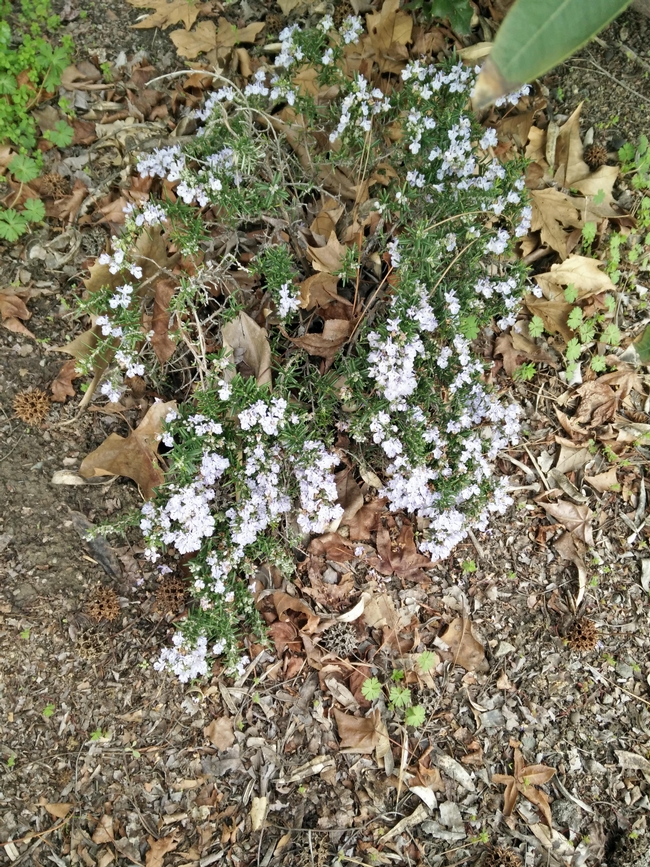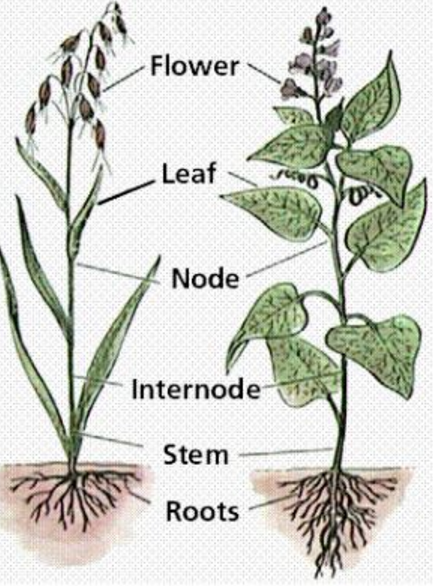Advice for the Home Gardener from the Help Desk of the
UC Master Gardener Program of Contra Costa County

Help Desk Response: Thank you for contacting the UC Master Gardener Program Help Desk.
You sent a photo of a plant for us to identify. It is rosemary (Rosmarinus officinalis). While it's not native to California (it originated in the Mediterranean area), it is very well adapted to California's similar Mediterranean climate. Its flowers range in color from various shades of blue to even pink and white. Its growth habit ranges from stiff and erect, rounded, or low and creeping, depending on variety or cultivar.
This plant is also the rosemary used for seasoning food, however some varieties taste better than others. Bees are attracted to the flowers and make excellent honey when feeding on them.
Good drainage and full sun are essential for a healthy rosemary plant. The links following will take you to more information about growing rosemary: http://ipm.ucanr.edu/PMG/GARDEN/PLANTS/rosemary.html and http://sonomamg.ucanr.edu/Plant_of_the_Month/Rosemary/.
Happy gardening!
Help Desk of the UC Master Gardener Program of Contra Costa County (SEH)
Note: UC Master Gardeners Program of Contra Costa's Help Desk is available almost year-round to answer your gardening questions. Except for a few holidays (e.g., last 2 weeks December), we're open every week, Monday through Thursday for walk-ins from 9:00 am to Noon at 2380 Bisso Lane, Concord, CA 94520. We can also be reached via telephone: (925) 608-6683, email: ccmg@ucanr.edu, or on the web at http://ccmg.ucanr.edu/Ask_Us/. MGCC Blogs can be found at http://ccmg.ucanr.edu/HortCoCo/ You can also subscribe to the Blog.
Advice for the Home Gardener from the Help Desk of the
UC Master Gardener Program of Contra Costa County
Client's Request: I'm expanding my garden significantly. I really can't afford the cost now to buy a lot of nursery plants. Instead, I'd like to propagate more of my Star Jasmine and Upright Rosemary. Please provide me some guidance on how I can do that.
Help Desk Response: Thank you for contacting the UC Master Gardener Program Help Desk with your questions on the propagation of your upright rosemary and Star Jasmine. With some reasonable care, you should be able to readily propagate these plants for your garden.
Upright Rosemary (Rosmarinus officinalis) is propagated from softwood cuttings of the non-flowering branches in early summer. You can also layer established low branches by scooping a shallow trench, burying the branch, and putting a rock over it to keep it from springing up. There should be enough roots on the new plant in about 6-8 weeks to detach and transplant it to a new location. Rosemary is relatively easy to propagate, that you may also be able to start your softwood cuttings in water and then transplant them to a container mix or possibly into the ground with some tender care and oversight during the initial planting and maintenance.

Star Jasmine (Trachelospermum jasminoides), is propagated by taking semi-hardwood cuttings in summer. Cut a 10- to 12-inch length of vine from a vigorous star jasmine plant. Use clean pruners or a sharp knife to make the cut just below a node, which is a small swelling where a leaf or bud emerges. Divide the vine into 3- to 4-inch stems, with each cut just below a node.
I have attached some additional hints and references below that cover all steps of softwood and semi-hardwood propagation and that also include more detail about what type of planting medium and containers that you can use.
A Few Hints for Successful Propagation:
- Cutting materials should be free from pest and disease, young and succulent, and preferably not flowering. Tip cuttings should be able to bend but not break.
- The cuttings should be dipped into a rooting hormone for inducement to produce roots. Examples of the types of rooting hormones available are Hormex (powder) and Dip n Grow (Liquid). Independent nurseries usually carry these products, and they are also available online (e.g., Amazon, etc.). Low strength hormones should be used for your cuttings. Using too high a concentration of hormone solution will cause the cutting to fail rather than increase the rooting ability. This is where more is not better.
- After cuttings have rooted (generally two to three weeks) they can be moved into a pot with a good garden loam mix. In transplanting cuttings, be careful of their roots. Lift cuttings from their tray by using a fork or a pencil or anything which can be put below to loosen and lift them without disturbing the roots excessively.
- Keep the cuttings in a shaded area, and water regularly. Once their roots have filled out the pot (anywhere from 3 weeks to 6 weeks) they can then be planted into the ground., but will require extra watering and attention for the first several months
Here are some further plant propagation links that should also be informative:
http://ucanr.edu/sites/ucmgnapa/files/81929.pdf
http://ceyolo.ucdavis.edu/files/53420.pd
Please let us know if you have additional questions about propagation of your plants.
Good Luck!
Help Desk of the UC Master Gardener Program of Contra Costa County (SLH)
Don't miss our 2017 Great Tomato Plant Sale:
http://ccmg.ucanr.edu/EdibleGardening/GreatTomatoPlantSale/
Note: The UC Master Gardeners Program of Contra Costa's Help Desk is available year-round to answer your gardening questions. Except for a few holidays, we're open every week, Monday through Thursday for walk-ins from 9:00 am to Noon at 75 Santa Barbara Road, 2d Floor, Pleasant Hill, CA 94523. We can also be reached via telephone: (925) 646-6586, email: ccmg@ucanr.edu, or on the web at http://ccmg.ucanr.edu/Ask_Us/ MGCC Blogs can be found at http://ccmg.ucanr.edu/HortCoCo/ You can also subscribe to the Blog (http://ucanr.edu/blogs/CCMGBlog/).
- Author: Shannon Wolfe
Thanksgiving is tomorrow, so I am sure you have all the ingredients you might need for your upcoming feast. Lots of herbs make their way off the shelf and into this wonderful meal, so I thought this would be a great time to discuss some of the most popular herbs used in the traditional Thanksgiving meal, and give some tips on growing and storing them. If you don't already have any or all of these three herbs in your garden, you might consider planting some once spring rolls around.
Rosemary
Rosemary is always a popular herb - and a popular decorative shrub in our area as it is hearty and drought-tolerant. For Thanksgiving use, you can use a rosemary-salt blend to rub your bird, or finely chop and combine fresh rosemary with butter and rub that on your bird. Whole sprigs can also go straight into the cavity of the bird. Rosemary roasted potatoes are also a delicious side dish.
You might already have rosemary, either creeping or upright, in your landscape. If you don't, and would like to grow some, you should! Rosemary is very easy to care for. It prefers 6-8 hours of sunlight per day and thrives in our warm climate. Rosemary likes dry soil - so be sure not to overwater and let the soil dry out between waterings.
Thyme
Thyme is a popular herb to combine with poultry, but this lemony herb also goes well in baked goods. You can rub some thyme on your bird, throw some sprigs inside the cavity, or even toss some thyme into your piecrust dough.
Much like rosemary, thyme can make a great decorative accent in your garden. Many gardeners believe that the flavor of thyme improves the more it is neglected - meaning poor soil and little water suit thyme just fine.
Sage
Sage complements pork very well. It also adds a savory flavor to browned butter, and who doesn't love sage stuffing?
There are many types of sage, and not all of them are edible. These varieties are all edible: garden, purple, tri-color, golden and common sage. Another giveaway for edible sage is the botanical name "salvia officinalis." Sage prefers full-sun and is drought-tolerant once established. It prefers well drained soil and does not like to have wet roots.
Harvesting and Storage
As far as harvesting goes, you can cut sprigs of rosemary, thyme and sage as needed to use fresh, or you can cut and hang sprigs to dry. Once dry I do recommend removing the needles or leaves from the stem and putting them in a jar or bag of some sort, as no one likes dusty herbs!





